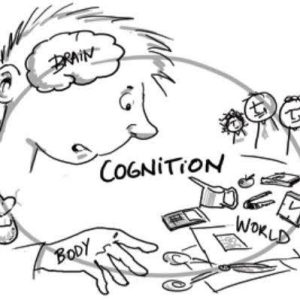Where does the mind stop and the rest of the world begin? That was the opening sentence of a now-classic paper [1] that, in 1998, set out to question a picture that dominated the scientific study of the human mind. According to that picture, what we call ‘mind’ is essentially just the activity of the brain. The brain’s activity might cause things to happen in the (rest of the) body, and bodily actions might cause things to happen in the world. But all the actual thinking and reasoning (so the traditional story claimed) was taking place inside the head, locked away behind the ancient barriers of skin and skull. We can call this picture the ‘brain-bound’ view of mind. The 1998 paper rejected that popular, and still highly influential, view. Human minds, it argued, are better understood not as hidden inner things but as extended processes- sets of shifting, unfolding interactions that repeatedly criss-cross brain, body, and world. Mind, in other words, is not ‘all in the head’.
To get the general idea, consider ‘thinking through writing’. When we are trying to make sense of complex matters, we often find ourselves writing things down. On the brain-bound picture, the process of writing is not itself part of the thinking—it is merely an effect of the thinking, all of which takes place inside the head. But on closer examination, that does not seem correct. At the very least, it often feels to us as if the writing and the thinking are more tightly bound together than that, as if the writing is in some real sense part of the process of thinking things through. According to the thesis of the extended mind, this is indeed the case. The action loop running through the medium of pen and paper (or keyboard and screen) creates an extended system. Within that system, unfolding processes in brain, body, and world are tightly coupled together, each exerting a continuous influence on the others. Extended mind theorists claim that it is this distributed process—not just the brain-bound activity alone—that (at that time) provides the true machinery of thinking.
Mobile devices such as smartphones and smart watches offer another compelling demonstration. Parted from my smartphone I feel significantly less capable, impeded in my abilities to plan, reason, and navigate. Over time, the activities of my biological brain have come to ‘expect’ the many functionalities made available by the near-constant presence of the phone. My brain simply expects to be able to become coupled, whenever necessary, to the various devices that make those functionalities available, just as it ‘expects’ to be continuously coupled to a body, that can in turn access notepads, smartphones, and computers. The brain learns to act as a partner in multiple coupled unfoldings implicating bodily action, external devices and media, and the wider world – including other people. If the extended mind thesis is correct, it is these partnerships, and the rules and principles that govern them (so not merely the activities of the biological brain) that we need to understand if we are to understand ourselves as the real-life, real-world, thinking systems that we are.

When people first encounter these ideas, they sometimes respond by arguing that there must still be a stable, fixed mind or self somewhere at the core —a ‘you’ that is constantly orchestrating all these interactions. That is the final, and perhaps the deepest, error of the brain-bound view. According to its most radical proponents [2], we should not identify ourselves, or our minds, with the brain-bound element alone. We may allow that the biological brain plays a major role in helping to launch the right actions at the right time, so as to make the most of the opportunities made available by the body and world. But to go further, to think that that brain-bound element is all there is to ‘you’, would be a bit like mistaking the catalyst for the whole chemical reaction, or the boot program (the bundle of start-up code that initiates all the other programs) for the full up-and-running system.
Another popular response is to ask why we should care about these exotic questions. Does it really matter whether we think of ourselves as essentially the activities of our brains or as something larger, less stable over time, and less clearly separated from the body and the wider world? One reason it may matter is when thinking about the increasing number of people who now rely on smartphones and other devices to cope with mild dementia and other kinds of disability [3]. We should not think of these people as necessarily cognitively diminished just because their abilities to plan, navigate, and remember now require a little more technological support. A better comparison is with prosthetically enabled athletes whose genuine abilities (to walk, run, play soccer) now happen to involve some non-biological parts and processes. This perspective will become increasingly important as we move towards a future in which typical human beings are likewise multiply augmented using mobile devices, smart clothing, and neural implants.
We humans are natural cyborgs: peculiar animals that run in training shoes and think with notepads, sketchbooks, and computers. We are not—and never have been—fixed minds or stable selves locked away behind the barriers of skin and skull. Instead we are shifting, fluid, organizations whose elements and boundaries are constantly negotiated and in flux.
Perhaps this may lead us to take better care of the worlds we build and live in—for we are not truly distinct from those worlds.

